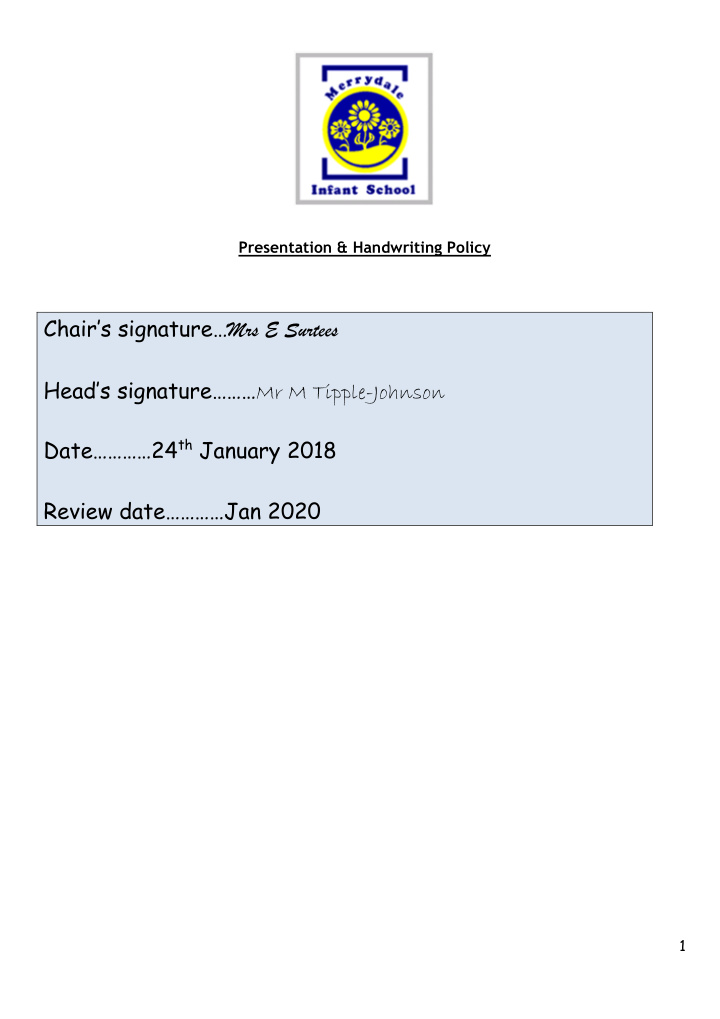



Presentation & Handwriting Policy Chair’s signature… Mrs E Surtees Head’s signature……… Mr M Tipple-Johnson Date………… 24 th January 2018 Review date………… Jan 2020 1
Presentation 1 Book covers should indicate: Child’s ful l name Class name Subject Children should not write on the covers of their books 2 Date of work in books: Full written date in literacy books, digital date for numeracy and theme work Teachers are encouraged to work towards this standard as soon as children are able Date is left aligned and underlined with a ruler 3 Title of work in books: It is not necessary for children to write the learning objectives in their books for each piece of work, but titles should reflect the content of the learning for the lesson Titles should be centred and underlined with a ruler Teachers are encouraged to work towards this standard as soon as children are able 4 Finishing work: Space should be left at the end of each finished piece of work for teacher’s comm ents and child ren’s responses General presentation Children should use pencil crayons when illustrating work in books Teachers should encourage a good standard of presentation overall Errors should be crossed out with a single pencil line Children may use rubbers at the teachers’ discretion 2
Display There should be an appropriate emphasis on current literacy and numeracy work on display in the classroom. Where display space is limited in teaching areas, displays should be used as tools for teaching and learning. Each display should include a written explanation of the content and purpose of the learning that has led to the work shown. Displays should have clear titles and children’s work should be named A range of borders, colours and styles is to be encouraged e.g. a balance of handwritten and computer fonts for titles Displays should celebrate and reflect recent work. Teachers should ensure that displays are changed regularly, at least every half term. Classes will be responsible for some boards in communal areas of the school. Corridors should display a range of work from different year groups. All subjects of the curriculum should be represented in displays. An SMSC board will always be displayed in the hall. Where display space is limited in teaching areas, displays should be used as tools for teaching and learning. Handwriting All staff teach from the Nelson Penpals scheme. In EYFS a “preparation” for handwriting approach is taken with a range of activities, including art and P.E. Handwriting development stages are reflected in both the writing and the physical development strands, with writing opportunities always available in the environment. In Key Stage 1, the Penpals scheme gives clear and specific guidance about letter formation, letter joining, and advice for left-handed writers. It also provides a progression for teaching and learning. Activities that develop gross and then fine motor control should be included in daily Foundation Stage provision. There should be a minimum of three handwriting sessions, each of fifteen minutes, taught weekly in Key Stage 1. Children need opportunities in each session to comfortably watch the teacher model handwriting and to refine their developing handwriting skills. Whilst there are age related expectations for handwriting as set out in the statements below, it is understood that children will develop at different rates and that provision for this must be made through careful differentiation during handwriting sessions. Handwriting skills should be encouraged in cross curricular work. The assessment of handwriting is incorporated into overall writing sub level assessments. The progression of skills in handwriting, in EYFS developmental stages, is as follows – 40 - 60 Months, Physical Development • Shows a preference f or a dominant hand. • Begins to use anticlockwise movement and retrace vertical lines. • Begins to form recognisable letters. • Uses a pencil and holds it effectively to form recognisable letters, most of which are correctly formed. The progression of skills in handwriting - Will tolerate hand manipulation Will attempt to mark make independently Can use and enjoy mark making materials Can show some control in mark making Can use a pencil and hold it effectively Can form most letters correctly Can show some control over size, shape, orientation in writing Can usually give letters a clear shape and orientation 3
Can control the use of ascenders/descenders, upper/lower case letters, although shape and size may not always be consistent Can use accurate and consistent handwriting, with consistent upper/lower case; ascenders/descenders, size and form Begins to show evidence of joining handwriting Can use cursive script accurately and neatly, although may be slow 4
Recommend
More recommend